#gay vampire stuff
Explore tagged Tumblr posts
Text
So why are there so many gay vampires?
From the time of Carmilla all the way up to the works of Anne Rice (a universe that seems to get only less subtle as the years go on), gay vampires have been a thing basically as long as anyone was writing about vampires. Lesbian vampires have been a genre all their own for decades. Bram Stoker, author of the most famous vampire novel ever written, was gay himself. So why vampires specifically?
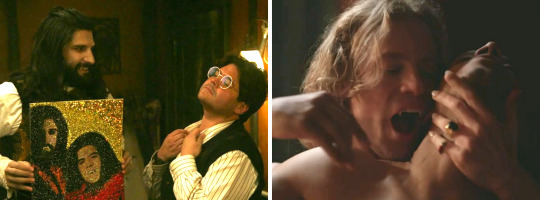
I’ve seen people attempt to answer this one before, and there are all sorts of contributing factors I could point to here, from the genres’ beginnings with Lord Byron (infamous bisexual disaster fuckboy), to modern discourse about why queer folks so often find themselves identifying with the monsters and outcasts of fiction. Few other monsters besides vampires can so easily pass for ‘normal’, or are nearly so well known for their snappy dress sense and ‘unnatural cravings’ for human flesh. And that’s without even getting into all those skeezy outdated stereotypes casting queer people as predators, or the idea that even one ‘gay experience’ could somehow ‘convert’ you into being one yourself.
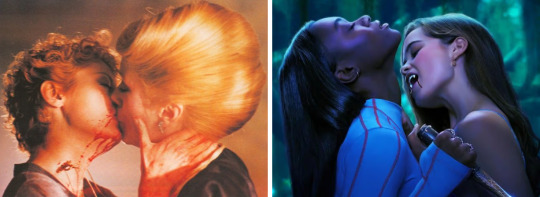
But to my mind, there’s just one really important thing that makes vampires so gay, and it’s the same thing that makes them sexy in the first place: plausible deniability.
You see, a vampire’s bite is simultaneously a) ridiculously sexual, and b) not even a little bit sexual at all.

You don’t have to look far for vampire canons where there’s nothing sexy about being bitten by a vampire. Bloody, violent, painful, sure ‒or just clinically miserable, human bodies torn open or hung up to drain like a human blood bag. What’s sexy about getting bitten by a mosquito, or a fecking leech? The diet of the actual vampire bat requires it to process so much water that it apparently spends mealtimes busily pissing out the difference, and the anti-coagulants in its saliva leave the wound bleeding messily long after it’s gone. The basic act of feeding is no more inherently sexual for a vampire than it is for a zombie.
Vampires are even a surprisingly acceptable monster to market to children. There’s a vampire muppet, a cartoon about a vampire duck, and a whole series of books about a vampire rabbit. You can put a vampire on the side of a cereal box without undue outrage. Vampires do not have to be R-rated for sex or violence.

So of course vampires will go after victims of the same sex. Do you stop to inquire whether the cow you’re eating was male or female? It’s all just predator and prey!
Until it’s everything but.
Do not let the ‘vampires aren’t supposed to be sexy!’-purists fool you. The tradition of sexy vampires goes all the way back to the oldest folklore, where the first victim of a newly-risen vampire was often their still-living spouse. Vampires were even occasionally known to get women pregnant (a convenient excuse for any widow who might turn up pregnant slightly too many months after their husband's death). The ‘original’ Nosferatu sounds more like an incubus than the naked mole-rat creature they made that movie about. The demon lover aspect of the vampire has been there all along.
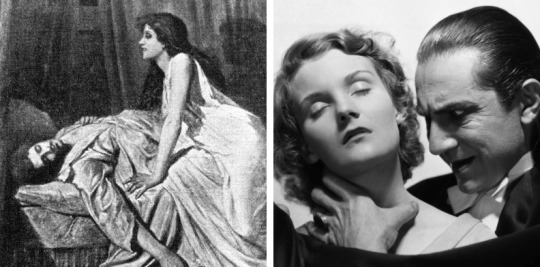
And it’s not hard to imagine why. If someone is biting and sucking on your neck, then either they’re a vampire, or they’re well on the way to second base (other folklore has its vampires feed directly from their victim’s heart, which is scarcely less suggestive). The implications of an exchange of bodily fluids were never subtle, even in Stoker’s day (I'm looking at you, Lucy-with-the-three-husbands), and the vampire as a sexual predator was a popular literary device well before Stoker's time. Beautiful vampire women would seduce men to their demise, and the males of the species might visit the bedroom of some innocent maiden time and again. The Victorian obsession with mesmerism, meanwhile, provided the perfect explanation for how victims might be hypnotised into eager compliance, and perhaps not even remember being fed upon at all. Vampires have been the ultimate guilt-free sexual fantasy since way back in the day, compatible with all your awkward Victorian mores! (Not quite ready to admit they're sexual fantasies? No problem: he's just here to, y'know, suck on your neck a bit. No subtext here!)
The whole act of biting is so suggestive that in the early years of vampire cinema, it wasn’t shown at all, not even between opposite-sex participants. The camera of 1922’s Nosferatu maintains a demure distance during the climactic scene where the heroine is finally bitten and slowly drained of blood, and Universal’s Dracula conveniently fades to black or cuts away whenever it’s about to take place. But even if the biting has to take place off screen, who’s to say a vampire isn’t going to pick victims of both sexes?

The stately tradition of the lesbian vampire has cinematic examples going all the way back to 1936, with Universal’s Dracula’s Daughter. Though the titular vampire has a nominal male love interest – a psychologist who naively advises her to confront her temptations without fear – the result of his advice is a famous sequence where she picks up a young woman under the premise of wanting an artist's model, and convinces her to remove her top. No actual biting or nudity is shown (it was only 1936), but her fate is left in little doubt.
By the era of 70’s sexploitation, all such subtlety had been abandoned. If we’re all good with naked boobs, who’s going to be offended by a little biting?

In fact, when it comes to men rather than women, a vampire bite was, for many years, far too sexy to be shown, or even alluded to. Nosferatu clearly feeds on that film’s Jonathan-expy, but our only evidence is the bitemarks on his neck in the morning, and the final sacrifice to defeat the evil monster must naturally be female. Universal’s Dracula had to ignore explicit studio mandate that only the brides should be allowed to feed on their own Jonathan-equivalent, as to even imply that Dracula himself had fed upon a man was obviously far too homoerotic to contemplate (never mind that it’s Dracula who must be established as the threat in this opening sequence, or that it’s Dracula his victim will spend the rest of the film obsessed with).
But in that unspeakable land of male-on-male homoeroticism, you might be surprised how much homo we can squeeze in even without resorting to fangs-in-necks. The Lost Boys is surely one of the most homoerotic vampire films ever made, but there, the one big blood-drinking scene is rendered in a bloody massacre of slasher-movie violence. And though Anne Rice certainly describes the scene where Lestat drains Louis of blood in lurid detail (and even has them spend their first sunrise together sharing a coffin), Louis is already thoroughly seduced before he ever reaches this point.
You see, the lore of the pop-cultural vampire conveniently comes with a second and equally-compelling target for plausible deniability: the act of making a new vampire.

Obviously, to work, this has to be deliberate. A world where anyone bitten by a vampire becomes one hasn’t much to offer us, and the relationship between maker and fledgling can just as easily be framed as parental, as recruitment into a cult, or purely transactional. But whichever way you twist it, the implications of choosing another to share in your own eternal youth and immortality… like, I don’t have to spell this one out for you, do I? Did I mention how that thing where a vampire’s traditional first victim tended to be their own mortal widow goes all the way back?
But if we’re not ready to be completely obvious with our mainstream audience, some alternative explanation can always be provided for cover. Lestat doesn’t really want Louis, he just wants Louis’ money! (He also really wants Louis.) The Lost Boys just want Michael to join their gang! (Their very, very pretty gang, who swan around in mesh shirts, tank tops and assless chaps.)

The two sides of the vampire-deniability coin aren’t mutually exclusive, either. Carmilla drinks her new paramour’s blood, but also gazes into her eyes while promising her you will be mine. Drinking blood is a key part of making a new vampire in so many vampire stories, after all.
Carmilla isn’t even the only gay vampire story of the Victorian era. I recently posted about two other fascinating examples, both featuring male/male pairings: one being pretty much just a gender-flipped version of Carmilla, and the other a tragic love story filled with significant "vampire = gay lover" metaphors (why oh why must the townsfolk keep us apart, when we’ll only ever be happy once we’re united once more?) This stuff goes surprisingly far back.
In fact, you can find queer subtext in vampire fiction that predates even Byron and Polidori. 1819's The Vampyre was the first published vampire story, yes, but the first known work of vampire-fiction in the English language is a poem published by John Stagg in 1810, also called The Vampyre (look, the genre didn’t exist yet, you didn’t have to be creative with your titles).
In brief, Stagg’s poem recounts a conversation between a wife (Gertrude) and her dying husband (Herman), whose dear friend Sigismund, lately deceased and deeply mourned, has returned as a vampire. Night after night, he crawls into Herman’s room to drain his blood. Herman’s fate is already sealed, but unless Gertrude takes action, it will surely be she that Herman will take as his own first victim when he rises from the grave.

There may be nothing intentional about the queer subtext of this tale. A vampire’s victims often include friends he knew in life, as Stagg himself cites in his introduction. But if Herman’s first victim will be his wife, what are we to read about the fact Sigismund’s first victim is Herman? Especially given how long he’s kept secret from poor Gertrude that his dear ‘friend’ has been climbing into his bedroom each night, lying beside him in bed and sucking and draining "the fountain of my heart!" while Herman moans and tosses (in pain, obviously!), always leaving him "exhausted, spent." Ultimately, Gertrude is saved only when both Herman and Sigismund are staked through the heart, and we close on the image of them slumbering together in the tomb.
It is, however you turn it, pretty gay.
I reiterate: this is the very first known work of vampire fiction written in the English language. The second was the one that was kind-of-written-by, kind-of-stolen-from, and unambiguously based on bisexual-disaster-fuckboy Lord Byron. And the two most influential works of vampire fiction of the next hundred years would be Carmilla, the very lesbian vampire story written by a… presumably straight man? And Dracula, the not-completely-convincingly-hetero story written by #1 Walt Whitman fanboy Bram Stoker. Vampires have always been very equal-opportunity kind of monsters.

There are, of course, plenty of influential heterosexual vampire tales to fill out the roster too. Varney the Vampire, a penny dreadful from the 1840s, was so successful it ran for over 200 chapters. The 1960s had their own wildly successful Varney-equivalent in the soap opera Dark Shadows. Love it or hate it, we really can't ignore Twilight either. My own introduction to the genre was Christopher Pike’s The Last Vampire series, which came out alongside the original Vampire Diaries novels. So there's plenty of material around to keep the straights entertained – and honestly, that’s only as it should be, because the very thing that makes vampires so queer-friendly is that the sex of their victims doesn’t matter. And it’s so easy to make vampires sexy (let alone a full vampire-proposal!) that even the Victorians could do it.
Now, if your reaction to all this theorising is to tell me "but the LGBTQ’s shouldn’t have to hide behind plausible deniability!" I can only counter, "well sure, but why should the straights have all the fun?" Because playing with all the ambiguity of "is this monster really just after my blood or is this going somewhere?" can be all sorts of fun, regardless of the genders involved. And as long as they’re up for exchanging bodily fluids with persons-and-or-victims of either gender equally, why not have some fun with it?

So, okay, maybe the real title of this post should have been "why are there so many pansexual vampires?" But the answer doesn’t change. Vampires have been the bisexual disaster fuckmonsters for as long as anyone’s been writing about vampires, and have been a metaphor allowing people publish barely-coded gay attraction since 1872. And much like the queer community, they’ve only become more complex, more sympathetic, and all the more popular as romantic paramours as the years have gone by.
#gay vampire stuff#Interview with the Vampire#Dracula#What We Do In The Shadows#The Lost Boys#Bram Stoker#Anne Rice#Carmilla#lesbian vampires
467 notes
·
View notes
Text

✧ bloodlust ✧
I'm starving, darling//Let me put my lips to something//Let me wrap my teeth around the world
[edit: thanks to all the love on this piece (which was just the WIP until now) I finally got the motivation to finish this after two months! Thank you to anyone who enjoys this for giving me the strength to finish this]
#yes i put lyrics to a Hozier song#I couldn’t take it any longer I had to post this#Oh btw the bottom right corner is stuff I wrote :) that’s not just anyone’s gay bloodlust yearning! It’s MINE :)#vampire tag#werewolf tag#my art#If the proportions are off… shhh ok. I’m used to drawing beasts and furries not people so forgive me#art#oc: wolf#oc: emil#pssss guys please click on the link ok thank u#that’s the playlist I made specifically for this art piece#vampire x werewolf#werewolf oc#werewolf art#vampire art#vampire oc#monsterfucker#monster x monster#terato#suggestive art#If you’ve made it this far in the tags then hiiiiiiii mewtuals <3#bloodlust boyfriends#blood moon bite#*voice of a guy who’s getting the blood drained out of him by his hot werewolf boyfriend in the middle of the woods in the night* woah is#this gay sex#FINALLY FINISHED THIS!!!!!
3K notes
·
View notes
Text

has anyone made this yet. is this anything
#my babysitter's a vampire#mbav#benny weir#rory keaner#ethan morgan#mbav stuff#sarah fox#erica jones#theyre all GAY!!!!!!#ur telling me a group of people who are DIFFERENT and come together because of their secret ARENT gay coded???? nah
610 notes
·
View notes
Text



Cover illustration and design for Sheridan Le Fanu's Carmilla 🦇❣
#my art#school stuff#original work#kinda lol#carmilla#sheridan le fanu#carmilla and laura#carmilla karnstein#art#book illustration#gay vampires am i right#vampire art
1K notes
·
View notes
Text
i made my religious southern black grandma watch the first ep of iwtv
most shameful thing ive done in a while, i already knew she doesnt like vampire or horror stuff because the blood disgusts her but shes really old and i wanted her to experience peak cinema atleast once
[my grandma is very open minded]
here are some reaction points ⬇
she automatically loves daniel malloy because hes old
she found "french white" to be a really funny phrase
i forgot that making her watch this meant i would have to sit through the sex scene. i spent 20 min trying to find an excuse and just as i got up ms. lily started rubbing her nipples, i knew this because my grandma started yelling WHATS SHE DOING? D:
my poor grandma was barely processing the ms.lily boob thing before my dad walked into the room. now theyre both witnessing this sex scene
she started laughing when louis pushed lestats hand away but when they started going at it she was like 👁👁 ?? and i had to explain that he was being seduced and also theyre freaky
"you know this doesnt suprise me, i heard new orleans is known for gay people". i ask her to elaborate on this but she doesnt???
she gets bored again when its over but paul's death grabs her
the confession scene (which i think is the best in the series) makes her lock in so hard she sits up and cant even hear when we're talking to her
immediately starts screaming and telling louis to run when lestat starts killing those priests and cant stop saying WHAT. DONT LET THAT WHITE DEVIL IN once louis accepts and kisses him 😭
she still cant get past the gore but said that i can show her some more episodes next time. i won 😚
[i need to reiterate that my grandma is not homophobic but the blood was genuinely making her mad 💀 propose normally next time lestat]
#iwtv#i dont think i can force her to watch more lol#i feel bad#i know she hates vampire movies#my mom was also in the room. i forced her to watch one season and downloaded it on her phone even though shes always lowkey saying stuff#kept trying to say theyre making everything gay because shes a fan of the movie#THE MOVIE IS MID#kept trying to tell her anne rice was a real one and theyre very gay in the book but she doesnt listen#lestat de lioncourt#loustat#interview with the vampire#louis de pointe du lac#daniel malloy
226 notes
·
View notes
Text
iwtv is so interesting wdym they have full on gay sex in episode 1 itself but that isnt even the most intense thing that happens
#you forget about the gay sex cause they do so much other much more toxic yaoi stuff#i love lestat hes like. the gayest most toxic boyfriend/lover/husband/master/creator ever#the toxic yaoi is Real and Thriving#iwtv#iwtv amc#interview with the vampire#lestat de lioncourt#louis de pointe du lac
83 notes
·
View notes
Text
my dad was making breakfast while i was watching the umbrella academy in the next room and as he walked out he asked me “is that one of those gay vampire shows?”
#funnily enough klaus had the most screen time while he was listening in so yknow what#yes it is#klaus is a gay vampire in my heart so sure dad it’s a gay vampire show#laur says stuff#the umbrella academy#tua#umbrella academy#five hargreeves#tua s4#hargreeves siblings#tua season 4#number five#tua five#klaus hargreeves#tua klaus
61 notes
·
View notes
Note
I don’t think that people get angry just cause other people romanticise vampires and relationships between vampires and humans in general. But people do get irked and bothered when other people romanticise some vampire media ignoring obvious rape, pedophilia, death threats, maiming, etc in it between vampire and human character, instead pretending it’s just some freaky love story aww or something and insisting on it. Cause there’s difference between what types of vampire x human relationships have what in it and how they pan out. So some call-out posts about that on Twitter are frankly speaking fair. Depends on vampire media they talk about of course.
Oh you didn't actually understand a thing I said huh. All of these are the basis for the vampire genre, liking the genre you have to be ok with a certain level of violence and unhealthy dynamics at minimum. Everyone who likes those knows its not good irl oh my god. This is all repackaged "women are too stupid to understand fiction". Anyway here are some popular vampire media relationships with rape, pedophilia, death threats, maiming in that order


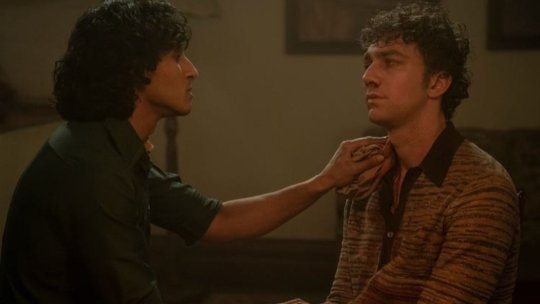

#anonymous#i'm crying we can't even like fictional relationships with death threats anymore cause of woke#'i want my vampire/human relationships clean and healthy and normal' ok....#is this no longer the will/hannibal website once again what is going on#or are we doing the stupid 'its only ok if its gay' stuff again#sorry to all my followers about all this
44 notes
·
View notes
Text
Hiya everyone, please buy my book it has boys kissing boys, girls kissing girls, and falling for magical creatures that definitely kill and eat you, but like in a yearning way!
DeVulpe's Dossier https://a.co/d/f3LdFlY
#writing#poetry#sapphic#love poem#spilled poetry#writingpoetry#writing prompt#spicy stuff#authors#new books#mlm yearning#wlw yearning#gay yearning#monster fucker#vampire lover#siren#my muse
32 notes
·
View notes
Text
Queer lit of the 1800s: Two gay Victorian vampire stories you've probably never heard of
So, I have this post in the works tackling that all-important question: just why are there so many gay vampire stories? But in writing it, what was supposed to be a brief tangent about a couple of little-known m/m vampire stories from all the way back in the late 1800s era… started expanding into something not-so-brief, as such tangents are prone to do.
But what the hell, the internet tells me it's queer history month: clearly the only solution is to give those stories their own post, where my tangent can spin out as far as it likes!

Now, if you know anything about Victorian vampire literature or the lesbian vampire genre, you’ve probably already heard about Carmilla, by Sheridan le Fanu (1872), the world’s very first (known) lesbian vampire story. To this day, it's easily the second best-known and widely adapted tale in all the Victorian vampire canon (after Dracula, obviously) – and it probably deserves to be too.
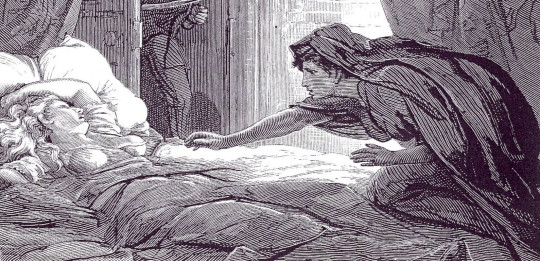
But this is not a post about Carmilla, because Carmilla is not the only gay-vampire-story written way back in the Victorian era. It's not even the least subtle gay-vampire-tale.
There are (at least) two others, both featuring male/male vampire/human pairings. And whether or not they ‘deserve’ to be remembered in the same breath as Carmilla, they’re both fascinating works in their own rights: Manor, by Karl Heinrich Ulrichs (1884) – one of the world’s first gay activists – and A True Story of a Vampire, by Count Eric Stenbock (1894).
You can read both online. A True Story of a Vampire is long out of copyright and can be found on Gutenberg (Carmilla is too, if you're interested), and many other places. Manor has been translated into English only much more recently, but you can still get hold of it in pdf form, or buy it in ebook format. But if what you really want are some summaries, and/or whole lot of extra context and analysis to go with the stories themselves, I've got you covered below.
Manor (1884), Sailor Stories, and Karl Heinrich Ulrichs
We’ll start with Manor, since it was published ten years before our other example, and because I’m not quite cruel enough to leave you going "wait, did you really just tell me there was a legit gay activist writing vampire slashfic in his free time way back in the 1880s?" while I ramble on about the other story first. We'll start with the author himself, because his own story is at least as interesting as any fiction he ever published.
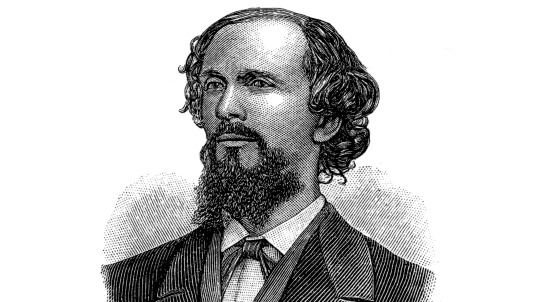
Born in Germany in 1825, Karl Heinrich Ulrichs knew from a young age that he was attracted to men. He trained in law, but wisely resigned before he could be fired in 1854 when his proclivities came to the attention of his superiors. Most in his position would've redoubled their efforts to hide; Ulrichs spent the next several years joining societies dedicated to science and literature and developing his own theories about non-hetero orientations, before officially coming out to his family in 1862.
He was just getting started. By 1867, he was ready to come out to the whole world.
Ulrichs is far from the first gay man to recognise his attraction without shame and find society in like-minded individuals ‒ but he may well be the very first to come out voluntarily and publicly, and advocate for the decriminalisation of homosexuality. And when I say "publicly" what I mean of course is, "in a formal address to the Congress of German Jurists." He was shouted down, but it was still a staggering act of bravery for a man of his time. It would still be a staggering act of bravery in many parts of the world today.
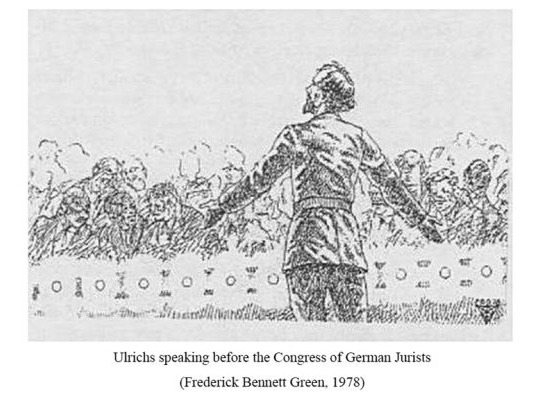
Undaunted by his reception, Ulrichs would also publish a dozen booklets advocating for rights for his community between 1864 and 1879, framing their sexuality as natural, inborn and wholly benign. In 1880, after multiple arrests for his political advocacy, he left Germany for self-imposed exile in Italy, where he would remain until his death in 1895. But it's during this period that he published some poetry, as well as Sailor Stories, a collection of four short stories inspired primarily by Norse mythology, including Manor (which we’ll get to, don’t worry).
Though Ulrichs saw little legal success in his lifetime, through modern eyes, his greatest failure might be only that he was so far ahead of his time. When he began writing and advocating, the word 'homosexuality' didn't even exist yet ‒ he himself used the term 'Urnings' for gay men, eventually coining terms for variations like 'Mannling' and 'Weibling' (gay male equivalent of 'butch' and 'femme') as well. He also came to recognise bisexuality, lesbian attraction, and even intersex conditions, theorising that all resulted from some combination of male and female characteristics developing in the same individual, as the available knowledge on embryonic development suggested might be possible. For a guy with only Victorian era science to work from, that's still remarkably close to the modern consensus today.
Nor did Ulrichs' work die with him. His writings would go on to inspire and be republished by gay rights movements that followed him ‒ including the work and advocacy of Magnus Hirschfeld, who created what may be the world's first trans-affirming clinic. Even in his own time, responses from his own readers show much his work meant to them, reassured at last that they weren't alone.
So how does a German activist from the 1880s find himself publishing gay vampire fiction based on Norse mythology while living in exile in Italy? I only wish I knew. My sources suggest his main goal with Sailor Stories was to publish something that would sell. Unsurprisingly, given the subject matter it seems to have sold very little. Manor is the third of four short tales, and by far the gayest of them all. It's also (IMHO) by far the best, and the most interesting.

Set in a Norwegian fishing village, Manor tells the story of the romance between a 15-year-old boy called Har, and the titular Manor, a sailor 4 years his senior, who rescues Har from the wreck which killed his father. In the days that follow, the pair become close, and Manor takes to swimming across the bay on summer evenings to visit Har at his home. And so they meet whenever they can, until tragedy strikes again, and Manor is killed in a shipwreck near the coast, leaving Har inconsolable with grief.
But this being a vampire story, in the nights after Manor’s death, something is seen swimming across the bay to Har’s home, just as Manor used to do. Har is visited night after night by the spectre of his beloved, who lies beside him in bed, strokes his cheek with cold hands, and kisses him with icy lips, draining his blood from his heart, "like an infant at its mother’s breast." Har himself awaits each night with mixed joy and fear, longing to see Manor again, even in such a form.
As Har weakens, the villagers attempt to trap Manor in his grave by hammering a stake through his body, but he continues to visit Har nonetheless, now sporting a gaping wound in his chest. The villagers return with a new stake, widened at the base like a giant nail, and finally, Manor is restrained in his grave. But it’s too late for Har: weakened and heartsick, he dies, begging only that he should be buried beside his beloved at last. Neither rise again.
Though I can’t speak to how it reads in the original German, in translation, Manor is relayed in largely workmanlike prose. Its tale is short, simple, and sad – but so much about it fascinates me all the same.

(Draugen, Theodor Kittelsen, 1891)
There’s the incorporation of elements you might better recognise from Norse draugr folklore – revenants more typically associated with deaths at sea, or charged with guarding their own graves ‒ but still far more closely related to the vampires of Slavic mythology than most people probably realise. Manor is also one of painfully few stories which clearly recognises what is surely the original purpose of hammering a stake through a vampire’s body: not to kill it, but to hold the creature down and prevent it from leaving its grave. As a hopeless vampire-nerd (I've presented panels at conventions about this stuff, it's dangerous to get me started), I can’t tell you how much I love those aspects of this story.
But above all, Ulrichs’ tale captures what might be one of the oldest and most traditional versions of the folkloric vampire: the spectre of a lost loved one, and the potent mixture of fear and twisted longing thus inspired, that the weight of their loss might drag you down into death to join them. Many ‘real’ tales of vampirism have been inspired by outbreaks of wasting diseases like consumption, working their way through a family, one member at a time. But in Har’s case, it is clearly grief as much as Manor’s physical visits that claims him. He loves Manor so much that he welcomes his lover back, even as a revenant. In his own way, Har too is cursed by Manor’s death to wander the world like the walking dead, until finally reunited with his lover once more.
Nowadays, tragic love stories like this tend to get an eye roll from a lot of the queer community. The old ‘bury your gays’ trope has been done to death, and we’re largely sick of being told that noble suffering is the best we can hope for. But it’s notable nonetheless that Manor’s sexuality has no bearing on his death, and little about the story would change were Har female. It's far from clear if the rest of the village even recognises Har and Manor's love for what it is, let alone whether they'd disapprove ‒ after all, vampires will often go after friends and acquaintances when lovers and family members are exhausted. As such, it’s hard to read the village’s attempts to keep Manor in his grave as a simple matter of prejudice. They're also genuinely trying to save Har's life.
And yet, the way Har keeps the undead Manor’s visits a secret, even begging for the stake to be removed so they can resume, echoes the real experiences of so many gay and lesbian couples far too clearly to be accidental. And however disturbing to a contemporary audience, Har’s willingness to follow his lover to the grave leaves little doubt of the depths of his feelings. To an audience in the 1800s, even the most cliched example of bury-your-gays would be revolutionary.
Did I mention that this story fascinates me? There are layers to this thing.
For completeness, I’ve also read the rest of Sailor Stories (and you can too at the same link). Only one of the other three tales contains any queer romance: the first, Sulitelma, where a boy called Erich falls for a handsome sailor called Harald he meets aboard a spectral storm ship. But there's no happy ending: his sister falls for the same handsome sailor, and shoves Erich overboard to his death to eliminate her competition.
Atlantis, the second story in the collection, is a direct sequel to Sulitelma, but it's even more bizarre. Erich is barely mentioned, and instead we find ourselves reading a tale which I can only summarise as like something I might have found on fanfiction.net back in the early aughts, written by some 14yo trying to straightwash the original material. Here, Harald and some of his fellows go on shore leave to the land of the phoenix, populated by Greek nymphs and Cupid, and mildly comedic hijinx ensue. It is fascinatingly bizarre, but not exactly satisfying as a read (or a sequel).
The final story, The Monk of Sumboe, tells of how two close friends destroy their relationship and themselves with their fixation on the tale of an alluring siren. There's a solid concept in there somewhere, but it's far too short and abrupt to do much with it, and all the characters remain strictly heterosexual. But if there's one thematic detail that ties it to the rest of the collection (beside the many Norse elements), it's that hopeless longing for something others would warn you away from ‒ whether that be a phantom ship, a visit from a vampire lover, or an elusive siren. None of these tales end well for their protagonists, but we're drawn to sympathise with them nonetheless.
I cannot guess what reception Karl Ulrichs expected in publishing this book. Sailor Stories is neither a work that could expect good reception from mainstream audiences or a defiantly-radical queer masterpiece. What did people make of it in its own time? Was it read and cherished by at least a few boys or men like Har and Manor? I’d hope so, but I’ll probably never know.
If you'd like to read more about Karl Ulrichs, I can recommend (among my sources) this New York Times article for a quick overview of his work, or the various work of Michael Lombardi-Nash and Hubert Kennedy (link 2). You can also read the first chapter of his published correspondence online for free.
A True Story of a Vampire (1894), and Count Eric Stenbock
Our second Victorian vampire tale was first published in English, though it was written by a Swedish Count. Like Carmilla in its own day (and quite unlike Karl Ulrichs), both story and author seem to have flown largely under the radar until many years after publication, the queer subtext little noted or commented upon (if at all).

If nothing else though, A True Story of a Vampire aptly demonstrates that at least someone of that era spotted what Carmilla was really about – because he wrote his own version, only about men. Stenbock’s tale is effectively a much shorter, gender-swapped version of Carmilla – but with a larger age gap between vampire and victim lending the story uncomfortable pederastic overtones.
"Vampire stories are generally located in Styria; mine is also," it begins – though I couldn’t name you any vampire story from the era besides Carmilla set there. The narrator, the surviving sister of the vampire’s victim, is called ‘Carmela’, if you needed further proof.
Much like in Carmilla herself, the vampire, Count Vardalek (a Slavic term for vampire) arrives at their house after being forced to seek local hospitality when some convenient ‘accident’ interrupts his travels. There, he bewitches and slowly drains the life from her brother, Gabriel – a boy described in terms variously angelic and fey, a wild thing who befriends wild animals and would rather climb a tree to a window than take the stairs to his own room, but who cleans up beautifully for church – a sublime, cinnamon roll of a creature, far too good for this sinful earth, too pure. Gabriel is a true male equivalent of the likes of Dracula’s Lucy, feminised further still by his youth and innocence. Had a vampire not got him, one can only imagine he’d have eventually have been spirited away by the fairies.
Gabriel and the mysterious Count are drawn to one another immediately. Even as Gabriel wastes slowly away, he greets Vardalek eagerly each time he returns by throwing his arms around his neck and kissing him on the lips. Count Vardalek himself seems to be a vampire of the psychic variety, gaining in health and vitality while Gabriel wilts, merely after spending time in one another’s presence. Vardalek himself seems to genuinely regret Gabriel’s inevitable death, but unlike in Carmilla, there’s no rescue at our conclusion. Gabriel dies, and we’re given no reason to assume he’ll rise again.
To the modern reader, the true horror of this tale lies not with the vampires or even the homoeroticism, but with those uncomfortably pederastic implications. Gabriel can’t be more than twelve years old, his youth and innocence emphasised in his every description. Pains are taken to suggest that Gabriel’s own attraction to Vardalek is as much responsible for his fate as the vampire himself. Gabriel’s father is similarly bewitched by this charming stranger, and never recognises the danger, or the reason for his son’s tragic death. Even the narrator, his loving sister, cannot truly hate Vardalek for taking her brother from her – even when her father dies of grief soon after. Gabriel’s fate seems sealed from the moment the Count enters their home.
But knowing how often real child molesters get away with it, their actions excused or downplayed by their family, their victims accused of ‘seducing’ their abusers and made complicit in their own misery… I can only say that, for my money, A True Story of a Vampire is a very effective horror story in ways the author probably never intended, once you start to question the reliability of its narrator.
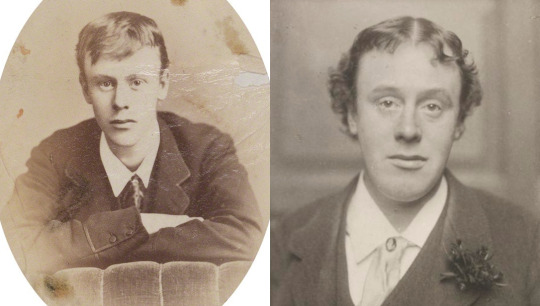
It won’t surprise you to learn that the author, Count Eric Stanislaus Stenbock, was a (very) gay man, deeply involved with the gothic and decadent artistic movements of his day. Born to a Swedish Count and an English heiress, Stenbock seems to be remembered less for his writing than for his character. In The Oxford Book of Modern Verse, 1892-1935, W.B. Yeats describes him as a "scholar, connoisseur, drunkard, poet, pervert, most charming of men" ‒ naming Stenbock as an exemplar of the poetic zeitgeist of the age. Notably however, none of Stenbock’s actual poetry is featured in the volume.
Stories about Stenbock are so bizarre that it’s hard to know how much should be believed. Eric Stenbock supposedly travelled with a multitude of exotic pets and a life-sized doll he referred to as his 'son', dabbled in religions ranging from Roman Catholicism to Buddhism, and decorated his dwelling with peacock feathers, oriental shawls, a bronze statue of Eros and a hanging pentagram. One acquaintance once compared him to a 'magnified child': "very fair hair beautifully curled, and a blond, round, blue-eyed face," who paused at the door and "took a little phial out of his pocket, from which he anointed his fingers, before passing them through his locks." But by his thirties, he was already dying of liver disease after years of alcoholism. He passed away at only 35.
Stenbock’s surviving artistic legacy consists of three volumes of poetry and one of prose, with some of those poems including explicit references to Ganymede or male lovers. So how did he escape the same controversy that dogged similar works by other queer creatives of his day, like Oscar Wilde or Walt Whitman – let alone Karl Ulrichs? Well, simple: his work never attracted enough attention to generate real controversy. Stenbock may have been just as much a character as figures like Wilde, but he hadn't nearly the same talent or success.
One last minor biographic detail that may be worthy of note (discovered courtesy of some very poor-quality scans of his one proper biography) is that the youthful Gabriel of A True Story of a Vampire may owe his name to a real Gabriele ‒ a female cousin ten years Stenbock’s junior, whom he would've spent time with in his teens, and seems to have been especially fond of. Whatever the true significance of that name, he'd use it more than once in his fiction: another short story, The Other Side: A Breton Legend, also stars an angelic little boy called Gabriel, with a similar dangerous attraction to the strange. It features some lovely mood and imagery as it sets the scene, but (perhaps as a result of the lack of a suitable model story like Carmilla) it is, in my opinion, a much weaker story overall.

But again, the most disturbing aspect of Stenbock's biography are the hints about his own relationships with much younger men. His second book of poetry, Myrtle, Rue and Cypress, is dedicated to three people: Simeon Solomon (a gay painter of the pre-Raphaelite movement, whom he met at Oxford), Arvid Stenbock, Eric's cousin, and to "the memory of Charles Fowler" ‒ the son of a Clergyman, who died of consumption at only 16.
This enigmatic dedication is all we know about Stenbock's relationship with Fowler. We don't even know how the they met (Fowler seems to have had a relative at Oxford at the same time as Stenbock, but even this is speculation). But that dedication, in a book which will go on to feature poems about the beauty of Ganymede, or explicitly addressed 'To A Boy' (Tis ever a delight, dear, To gaze upon thy face, To love the life within thee, Fair fashioned, full of grace) makes it hard to read Stenbock's feelings as remotely platonic.
It doesn’t help that the same volume includes a poem about an actual vampire, published ten years before A True Story of a Vampire would ever be penned, but with very comparable subject matter:
With slow soft sensual sips Draw the life from the tender spray, And brush from thy soft lithe lips The bloom of thy boyhood away
It's worth keeping in mind that Stenbock himself would've been only 21 at the time of Fowler's death, and that we don't know whether he ever acted on his attraction (whatever form it may have taken). He may well, as I've seen suggested, have kept his admiration private, idealising the image of the beautiful, dying boy in his final days, in that classic Victorian-gothic way. But it doesn't help that Stenbock's cousin Arvid, from that other dedication in the same book, was 8 years his junior, and that their family apparently disapproved of their relationship as "unnaturally close." Or that another famous Stenbock-associate was Norman O'Neil, a composer whom he met on a London omnibus in 1891, when O'Neil too was only 16. Stenbock was apparently taken by his intelligence and beauty, and would go on to leave him a considerable sum of money in his will. By 1891, Stenbock would've been 31, but his fixations hadn't aged with him.
So how are we to take all this? This was an age where a marriage between a 16-year-old girl and a suitor of Stenbock's age would scarcely have raised eyebrows. Uncomfortable as it may sound today, for many queer youths of the era, a romance with someone older and experienced enough to play mentor may genuinely have represented the safest real option available. There are layers of complicated subtext, meanwhile, in the idea of any gay man of the Victorian era casting himself as a vampiric monster, doomed to ruin the object of their attraction with their very touch. There may be layers more in Stenbock framing his tale as "A true story" before telling us of the misery a foreign Count brought to an innocent family, with his helpless fixation on their youngest child.
It's worth noting also that even in Manor, by Legit Gay Activist Karl Ulrichs, our love story is between a boy of 15 and a man of 19 ‒ an age gap of only 4 years, but large enough at 15 to raise some serious eyebrows. His first story too, Sulitelma, involves attraction between a man and a boy (exact ages unknown). Though Ulrichs explicitly viewed relationships with prepubescent children as reprehensible, he seems to have had no problem with relationships between young teens and much older adults ‒ even printing a story sent in by a reader (details in this article), joyfully recounting how he (the reader) was initiated into the world of male/male love as a 14-year-old by his brother's riding master. Ulrichs saw no reason to disapprove.
To confuse things for anyone looking this up today, google Ulrichs, and you'll find a number of online articles claiming that his own first experience involved being sexually assaulted by a riding instructor when he was only 14. This is wrong on multiple fronts: not only is the story related by Ulrichs as a positive experience, it wasn't even Ulrichs it happened to. No, shit like this would not be okay if it happened today (and frequently wasn't then), but we don't help ourselves by distorting the stories told by our queer forebears to fit modern expectations.
But none of that surrounding context makes the youth of the day any less vulnerable to predation, or Stenbock's fixation on youthful beauty less creepy. Today, no evidence remains to help us guess whether idealising the beauty and innocence of youth was the greatest of Stenbock's actual crimes, or the least of them. Anything is possible.
In brief: welcome to the joy of trying to reconcile the complicated place of pederasty in queer history! I'm afraid you can look forward to seeing a lot of it from here on back.
A True Story of a Vampire is not a bad work of fiction by any means. There are some lovely descriptions and entertaining turns of phrase, and the horror is certainly effective. It may even be considerably more readable than Carmilla to many, simply for being so much shorter. But how you feel about it is really going to be up to you.
One last digression about Carmilla and Christabel
There’s one additional work that I’ve once or twice seen listed as an even earlier queer vampire tale: Samuel Coleridge’s unfinished poem Christabel (1800) – the only problem being there’s no vampire in the story (and how queer it is may be questionable too).
Like Carmilla, Christabel tells of a Baron’s daughter (the titular Christabel) who comes upon a mysterious stranger in apparent distress (Geraldine) and invites her into her home. We never learn what kind of being Geraldine truly is (three further parts were planned in addition to the two that were completed), but when she undresses, Christabel spies something that horrifies her, remembering it later with the words "Again she saw that bosom old / Again she felt that bosom cold." But under Geraldine’s spell, Christabel’s recollection of this incident comes and goes, and Geraldine has soon bewitched her father too.

All ‘evidence’ that Geraldine was intended to be a vampire rests on such details as Geraldine having to be carried past an iron gate into the house, much as vampires have to be invited in – but that particular vampire trope wasn’t actually codified until a solid century later (like most vampire-tropes, we have Stoker's Dracula to blame). The idea that Geraldine has the cold, shrivelled body of the undead and revives herself on Christabel’s blood is a perfectly valid reading, but the more obvious interpretation would be that she’s some manner of shapeshifting fairy creature, weakened by the iron of the gateway, not the entrance to Christabel’s home. The aristocratic literary vampire had existed for over 40 years and appeared in numerous works of fiction by Carmilla's day; but Christabel predates the origins of the genre a solid two decades. For Coleridge to have come up with the idea independently seems vanishingly unlikely.
I mention Christabel here partly for completeness, but mostly to bring us back around to the greater family of Carmilla, which is still legitimately the first known queer vampire story. Though far better known than any other story discussed here today, how it came about is perhaps the most mysterious.
Sheridan le Fanu was a prolific writer, but I don’t know of any other story he’s penned with subtext like Carmilla's (and I’m not quite invested enough to read all of the rest to check, though someone totally should so I don't have to). Le Fanu was married, and had children, and that's all I can discover about his personal life. Was he some shade of queer himself? Did he have connections to anyone who was? Did he even realise what he was writing with Carmilla? Nothing I’ve read about him provides any answers. Nor can I tell you how many readers spotted the subtext it the story was first published. In its own time, it caused no great scandal, nor even seems to have garnered much attention (by contrast, Byron & Polidori's The Vampyre caused an uproar when it was published in 1819, mostly thanks to Byron's established fame and debates over its true authorship). It took until well into the 20th Century for it to obtain the reputation it has today.
But I’m sure it’s no coincidence that it was Carmilla that spoke to Stenbock enough that he chose to retell it. And while A True Story of a Vampire is still the only other vampire story of the era set in Styria, there was almost another one: Dracula, at least Stoker’s early plans for the novel. Styria also remains part of the unused prequel chapter later published as Dracula’s Guest. The setting isn’t the only detail Stoker nearly-borrowed from Carmilla either, my favourite example being the weird schedule by which both she and Dracula seem to have to be in bed in their coffins at dawn each day, both apparently helpless and immobile in sleep, though both are also repeatedly seen up and about later in the day. Neither tale offers any real explanation.
Have I mentioned lately that Stoker, too, was almost certainly some shade of gay?
Now, the fact that two different queer writers both found Carmilla so very inspiring – and would even both publish their own works of vampire literature within five years of one another – isn’t much to go on, in trying to establish what a story like Carmilla might’ve meant to England’s queer population some twenty years after it was written. Maybe Carmilla was being eagerly passed around London’s own Uranian gothic societies at the time. Or maybe two different men happened upon it by chance in wholly different circumstances, and took very different things from reading it. Maybe Stoker didn’t even notice the queer subtext himself. But I can’t help but wonder if just maybe, there's something more than coincidence at work here.
Carmilla the vampire is an explicitly villainous character, her victim confused and unwilling. But she remains one of the most complex and sympathetic vampires of her era. And perhaps, to a community who had never seen Ulrichs’ writing published in their own language, and might never see themselves represented in fiction except as monsters buried in layers of protective subtext, that still meant something to readers like Stenbock, and Stocker, and who knows how many others.
In short, maybe old, gay vampire stories like these really are worth remembering. I'll leave that one up to you.
#queer history#vampires#Dracula#Manor#Karl Heinrich Ulrichs#A True Story of a Vampire#Count Eric Stenbock#Carmilla#gay vampire stuff
86 notes
·
View notes
Text

83 notes
·
View notes
Text

being as old as sullivan is.. occasionally his art can be misplaced and just so happen to end up in a museum a good few decades later
#gacha community#gacha life 2#gacha oc#oc stuff#my ocs#i love my ocs#gacha life oc#ocs#gacha edit#gl2#gl2 edit#gl2 ocs#gl2 oc#gay vampires#vampire oc
36 notes
·
View notes
Text


Flustered (animation wips)
#booghowart#booghowanimation#Walter and vince#not an ask#not a shitpost either#work in progress#thesis stuff#Promposal#Walter#Vince#Gay#Werewolf#Vampire
212 notes
·
View notes
Text

hi guys rory again i know im mad late on this trend but shh
#my babysitter’s a vampire#mbav#mbav stuff#rory keaner#benny weir#bennory#mbav rory#mbav benny#wowgh what a shock that i drew him again#im on a train so i have way too much free time#i wonder if people actually listen to the songs i attach#stupid gay vampire show 🙁#Spotify#can you tell i can’t draw fellas with glasses#”rory doesn’t need glasses” SHUT UR TRAP HES BETTER WITH THEM 🙁
50 notes
·
View notes
Text

got a bit carried away with this one. more scene rory!
#mbav#mbav stuff#my babysitters a vampire#my babysitter's a vampire#rory keaner#rory mbav#picmix#blingees#blingee#glitter gif#glitter graphics#glittercore#old internet#old web#scene aesthetic#scenecore#scene kid#emo scene#scemo#2000s scene#scenemo#vampires#gay vampire#vampirism#vampire aesthetic#fangs
45 notes
·
View notes
Text
I want to cuddle you, wrap my arms around you, and just lean into you, my head on your shoulder.
Let me learn the way you breathe and the rhythm of hearbeat while you hold me
#mlm yearning#mlm post#nblm#mlm content#mlm stuff#emo mlm#mlm suggestions#mlm blog#gay mlm#mlm only#t4t mlm#vampire mlm#mlm thoughts#mlm
388 notes
·
View notes